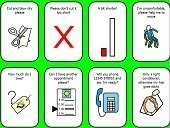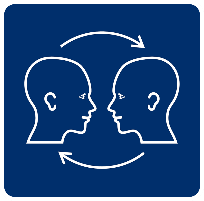A Communication chart is similar to a communication book but the items are arranged on a single board or sheet.
Some people have a number of charts, with vocabulary suited to specific activities. Thus they would take their ten pin bowling vocabulary chart to the bowling rink, their health chart to the doctor’s, and their haircut chart to the hairdresser’s. Other people will have all their core vocabulary on a single chart, such as a 400 Blissymbol chart.
Example of a communication chart:

A useful communication chart is a place mat for use when eating, with comments such as: “More please”, “That’s too much”, “I’ve had enough”, “Can you liquidize it?”, “What’s for pudding?”. Some shared homes organise chores charts with people’s names against specific household chores which are updated daily.
It is important to include instructions for unfamiliar communication partners on how to use the chart with the communicator. A Communication Passport is also a very helpful tool.
Text-based communication
AAC speakers with good literacy skills may choose to use spelling for most of their messages. A communication chart with the alphabet and a few high frequency words will allow the individual to say whatever they want, provided that the partner is able to read and remember the letters. Spelling charts are made in different sizes and layouts to accommodate specific physical needs.
If the AAC user is not able to point accurately enough, the partner may scan the rows of letters, and look for a signal from the AAC user when the desired item is reached.







